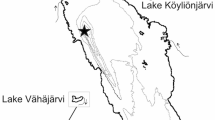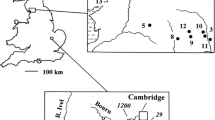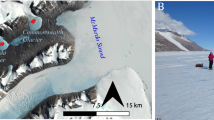Abstract
Glacier surfaces are known to harbour abundant and active microbial communities. Phosphorus has been shown to be deficient in glacial environments, and thus is one of the limits on microbial growth and activity. We quantified the phosphorus pool in cryoconite debris and the concentration of dissolved phosphorus in supraglacial water on Werenskioldbreen, a Svalbard glacier. The mean total P content of the cryoconite debris was ~2.2 mg g−1, which is significantly more than would be expected in rock debris from local sources. 57% of this P was present in the fraction defined as organic P. It may account for the P in excess of the rock debris, and could be explained by allochthonous input of organic matter. The concentration of total dissolved P in supraglacial water was very low (5.2–8.5 μg l−1), which was probably caused by efficient flushing and re-adsorption onto mineral surfaces. Dissolved organic P (DOP) was a very important component of the dissolved phosphorus pool on Werenskioldbreen, as concentrations of DOP typically exceeded those of dissolved inorganic P (or SRP) by more than four times in all the glacial water types. It is very difficult to assess whether P was limiting in this environment solely on the basis of the N:P ratios in the debris or biomass. There may be some degree of biological control over the C:N:P ratios in the debris, but the phosphorus cycling in the supraglacial environment on this glacier seems to be mainly controlled by physical and geochemical processes.






Similar content being viewed by others
References
Anesio AM, Mindl B, Laybourn-Parry J, Hodson AJ, Sattler B (2007) Viral dynamics in cryoconite holes on a high Arctic glacier (Svalbard). J Geophys Res 112:G04S31. doi:10.1029/2006JG000350
Bagshaw EA, Tranter M, Fountain AG, Welch KA, Basagic H, Lyons WB (2007) Biogeochemical evolution of cryoconite holes on Canada Glacier, Taylor Valley, Antarctica. J Geophys Res 112:G04S35. doi:10.1029/2007JG000442
Barrett JE, Virginia RA, Lyons WB, McKnight DM, Priscu JC, Doran PT et al (2007) Biogeochemical stoichiometry of Antarctic Dry Valley ecosystems. J Geophys Res 112:G01010. doi:10.1029/2005JG000141
Burkholder JM (1992) Phytoplankton and episodic suspended sediment loading: phosphate partitioning and mechanisms for survival. Limnol Oceanogr 37:974–988
Chadwick OA, Derry LA, Vitousek PM, Huebert BJ, Hedin LO (1999) Changing sources of nutrients during four million years of ecosystem development. Nature 397:491–497. doi:10.1038/17276
Cleveland CC, Liptzin D (2007) C:N:P stoichiometry in soil: is there a “Redfield ratio” for the microbial biomass? Biogeochemistry 85:235–252. doi:10.1007/s10533-007-9132-0
Foreman CM, Sattler B, Mikucki JA, Porazinska DL, Priscu JC (2007) Metabolic activity and diversity of cryoconites in the Taylor Valley, Antarctica. J Geophys Res 112:G04S32. doi:10.1029/2006JG000358
Hodson A, Mumford P, Lister D (2004) Suspended sediment and P in proglacial rivers: bioavailability and potential impacts upon the P status of ice-marginal receiving waters. Hydrol Process 18:2409–2422. doi:10.1002/hyp.1471
Hodson AJ, Mumford PN, Kohler J, Wynn PM (2005) The high Arctic glacial ecosystem: new insights from nutrient budgets. Biogeochemistry 72:233–256. doi:10.1007/s10533-004-0362-0
Hodson A, Anesio AM, Ng F, Watson R, Quirk J, Irvine-Fynn T et al (2007) A glacier respires: quantifying the distribution and respiration CO2 flux of cryoconite across an entire Arctic supraglacial ecosystem. J Geophys Res 112:G04S36. doi:10.1029/2007JG000452
Hodson A, Anesio AM, Tranter M, Fountain A, Osborn M, Priscu J et al (2008) Glacial ecosystems. Ecol Monogr 78:41–67. doi:10.1890/07-0187.1
Jania J, Kolondra L, Aas HF (2002) Werenskioldbreen and surrounding areas, Spitsbergen, Svalbard, Norway. Orthophotomap 1:25,000. University of Silesia, Sosnowiec, Poland
Jeffries DS, Dieken FP, Jones DE (1979) Performance of the autoclave digestion method for total phosphorus analysis. Water Res 13:275–279. doi:10.1016/0043-1354(79)90206-9
Karl DM (2000) Phosphorus, the staff of life. Nature 406:31–33. doi:10.1038/35017683
Kaštovská K, Stibal M, Šabacká M, Černá B, Šantrůčková H, Elster J (2007) Microbial community structure and ecology of subglacial sediments in two polythermal Svalbard glaciers characterized by the epifluorescence microscopy and PLFA. Polar Biol 30:277–287. doi:10.1007/s00300-006-0181-y
Krajewski KP (2000) Phosphorus and organic carbon reservoirs in the Bravaisberget Formation (Middle Triassic), Hornsund, Spitsbergen. Stud Geol Pol 116:175–209
Majka J, Budzyń B (2006) Monazite breakdown in metapelites from Wedel Jarlsberg Land, Svalbard—preliminary report. Miner Pol 37:61–69. doi:10.2478/v10002-007-0006-9
Marshall WA, Chalmers MO (1997) Airborne dispersal of Antarctic algae and cyanobacteria. Ecography 20:585–594. doi:10.1111/j.1600-0587.1997.tb00427.x
McQuaker NR, Kluckner PD, Sandberg DK (1983) Chemical analysis of acid precipitation—pH and acidity determinations. Environ Sci Technol 17:431–435. doi:10.1021/es00113a013
Mindl B, Anesio AM, Meirer K, Hodson AJ, Laybourn-Parry J, Sommaruga R et al (2007) Factors influencing bacterial dynamics along a transect from supraglacial runoff to proglacial lakes of a high Arctic glacier. FEMS Microbiol Ecol 59:307–317
Mueller DR, Pollard WH (2004) Gradient analysis of cryoconite ecosystems from two polar glaciers. Polar Biol 27:66–74. doi:10.1007/s00300-003-0580-2
Müller B, Stierli R, Wüest A (2006) Phosphate adsorption by mineral weathering particles in oligotrophic waters of high particle content. Water Resour Res 42:W10414. doi:10.1029/2005WR004778
Murphy J, Riley JP (1962) A modified single solution method for determination of phosphate in natural waters. Anal Chim Acta 26:31–36. doi:10.1016/S0003-2670(00)88444-5
Reddy KR, Kadlec RH, Flaig E, Gale PM (1999) Phosphorus retention in streams and wetlands: a review. Crit Rev Environ Sci Technol 29:83–146. doi:10.1080/10643389991259182
Redfield AC, Ketchum BH, Richards FA (1963) The influence of organisms on the composition of seawater. In: Hill MH (ed) The sea, vol 2. Wiley, New York, pp 26–77
Řehák J, Řehák S, Stibal M, Řeháková K, Šabacká M, Kostka S (2007) Glacier caves and drainage systems of the northern part of Hornsund area, southwest Spitsbergen, Svalbard. In: Abstracts of the 8th GLACKIPR Symposium, Sosnowiec, Poland, p 111
Rösler HJ, Lange H (1972) Geochemical tables. Elsevier, Amsterdam, 468 pp
Rudnick RL, Gao S (2004) Composition of the continental crust. In: Holland HD, Turekian KK (eds) Treatise on geochemistry, vol 3. The Crust Elsevier, Amsterdam, pp 1–65
Ruttenberg KC (1992) Development of a sequential extraction method for different forms of phosphorus in marine sediments. Limnol Oceanogr 37:1460–1482
Säwström C, Mumford P, Marshall W, Hodson A, Laybourn-Parry J (2002) The microbial communities and primary productivity of cryoconite holes in Arctic glacier (Svalbard 79°N). Polar Biol 25:591–596
Säwström C, Laybourn-Parry J, Granéli W, Anesio AM (2007) Heterotrophic bacterial and viral dynamics in Arctic freshwaters: results from a field study and nutrient-temperature manipulation experiments. Polar Biol 30:1407–1415. doi:10.1007/s00300-007-0301-3
Slansky M (1986) Geology of sedimentary phosphates. North Oxford Academic, London, 210 pp
Stewart JWB, Tiessen H (1987) Dynamics of soil organic phosphorus. Biogeochemistry 4:41–60. doi:10.1007/BF02187361
Stibal M, Šabacká M, Kaštovská K (2006) Microbial communities on glacier surfaces in Svalbard: impact of physical and chemical properties on abundance and structure of cyanobacteria and algae. Microb Ecol 52:644–654. doi:10.1007/s00248-006-9083-3
Stibal M, Tranter M (2007) Laboratory investigation of inorganic carbon uptake by cryoconite debris from Werenskioldbreen, Svalbard. J Geophys Res 112:G04S33. doi:10.1029/2007JG000429
Stibal M, Tranter M, Benning LG, Řehák J (2008) Microbial primary production on an Arctic glacier is insignificant in comparison to allochthonous organic carbon input. Environ Microbiol. doi:10.1111/j.1462-2920.2008.01620.x
Tranter M, Fountain AG, Fritsen CH, Lyons WB, Priscu JC, Statham PJ et al (2004) Extreme hydrochemical conditions in natural microcosms entombed within Antarctic ice. Hydrol Process 18:379–387. doi:10.1002/hyp.5217
Walker TW, Syers JK (1976) The fate of phosphorus during pedogenesis. Geoderma 15:1–19. doi:10.1016/0016-7061(76)90066-5
Welch SA, Taunton AE, Banfield JF (2002) Effect of microorganisms and microbial metabolites on apatite dissolution. Geomicrobiol J 19:343–367. doi:10.1080/01490450290098414
Wharton RA Jr, McKay CP, Simmons GM Jr, Parker BC (1985) Cryoconite holes on glaciers. Bioscience 35:499–503. doi:10.2307/1309818
Acknowledgments
This work was supported by BIOTRACS, an EU funded EST fellowship for MS. Jenny Mills (Bristol) is thanked for help with carbon and nutrient determinations, and Lesley Neve (Leeds) for XRD analyses. We thank Alexandre Anesio for comments on an earlier draft of the manuscript, and Andy Hodson and the associate editor Scott Bridgham for insightful comments which greatly improved our manuscript.
Author information
Authors and Affiliations
Corresponding author
Rights and permissions
About this article
Cite this article
Stibal, M., Tranter, M., Telling, J. et al. Speciation, phase association and potential bioavailability of phosphorus on a Svalbard glacier. Biogeochemistry 90, 1–13 (2008). https://doi.org/10.1007/s10533-008-9226-3
Received:
Accepted:
Published:
Issue Date:
DOI: https://doi.org/10.1007/s10533-008-9226-3




